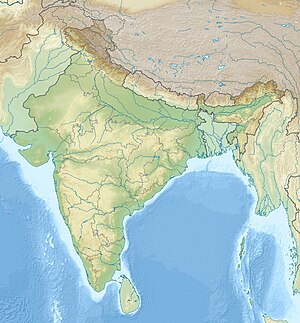Vigraharaja IV's first war against the Ghazanvids
| Battle of Khetri | |||||||||
|---|---|---|---|---|---|---|---|---|---|
| |||||||||
| Belligerents | |||||||||
| Kingdom of Ajmer | Ghazanvid Empire | ||||||||
| Commanders and leaders | |||||||||
| Vigraharaja IV | Khusrau Shah | ||||||||
| Strength | |||||||||
| Unknown | Unknown | ||||||||
Location of the battle of Khetri | |||||||||
Vigraharaja IV's first war against the Ghazanvid took place in the later half of the 12th century CE between the forces of the Ghazanvid Empire under Khusrau Shah of Ghazna and the Chauhan dynasty under Vigraharāja the great. In this momentous confrontation, the Chahamana ruler, successfully defended the region against the relentless onslaught of Muslim invaders from the northwest.
The engagement unfolded in Vavvera, situated six miles from the village Khetri near Jaipur, culminating in a triumphant outcome for Vigraharaja and his Army. This decisive victory not only marked the successful defense of the region but also resulted in the annexation of Hansi (Asika) into the Chahamana territory.
Background
[edit]During the initial stages of Vigraharaja IV's rule, India experienced a series of incursions by the Mlecchchas (a term denoting Muslim invaders). The gravity of the situation heightened when Amir Khusrau Shah, a formidable Ghaznavite Muslim leader, undertook a significant advance, reaching as far as Vavvera, a locality situated near Khetri in the Jaipur division of Rajasthan. The developments at Vavvera marked a critical juncture in the regional dynamics and set the stage for the confrontation between Vigraharaja IV and the invading Muslim forces.[1]
Battle
[edit]The Muslim leader Khusrau Shah extended an invitation to Vigraharaja, urging him to submit to his authority. In response, Srldhara, Vigraharaja's Chief Minister, advocated for a diplomatic solution, proposing the idea of negotiating with the invader through financial means. However, Vigraharaja, motivated by a profound sense of duty and honor, boldly rejected this diplomatic approach, deeming it disgraceful. The subsequent engagement unfolded as a fierce battle where Vigraharaja's forces successfully routed the Muslims. The outcome was a decisive victory that compelled the aggressors to retreat to their own dominions.[1][2]
Aftermath
[edit]Subsequent to his success in repelling the external threats, Vigraharaja IV shifted his focus towards offensive operations. As evidenced by the Siwalik Pillar inscriptions dated around V. 1220 (1163 CE), the Chahamana ruler orchestrated a series of strategic maneuvers that effectively liberated the majority of Hindu territories including Hansi(Asika) from Ghaznavite domination. By this period, only the Punjab region remained under Muslim control.[3][2]

The Prithviraja Vijaya, a historical account of the era, sheds light on Vigraharaja IV's proactive military campaigns during this phase. The narrative specifically highlights the capture of numerous hill-forts, indicative of the king's strategic acumen and the success of his expansionist endeavors. This offensive shift in Vigraharaja's approach not only secured the independence of Hindu territories but also showcased his determination to reclaim regions that had fallen under Muslim dominance.[4]
Legacy
[edit]While the Battle at Vavvera marked a significant defensive victory for Vigraharaja IV, the struggle against Muslim invaders continued. The annexation of the Tomara kingdom and the capture of Hansi (Asika) marked significant achievements in the Chahamana ruler's military endeavors. However, these triumphs did not fully satisfy Vigraharaja's ambitions.[2][5]
The Bijolia rock inscription, a testament to his strategic vision and forward-looking approach, underscored the importance of further conquests for the benefit of his descendants. Vigraharaja IV emphasized the need for future generations to continue the mission, highlighting the significance of conquering the remaining territories. Of particular importance was the Punjab region, which still remained under Muslim occupation. This strategic directive reflected Vigraharaja's unwavering commitment to expanding the Chahamana kingdom and ensuring the liberation of all Hindu territories from external dominance.[5]
See also
[edit]References
[edit]- ^ a b Dasharatha Sharma 1959, p. 60–61.
- ^ a b c Rima Hooja 2006, p. 245–260.
- ^ Dasharatha Sharma 1959, p. 61–62.
- ^ Dasharatha Sharma 1959, p. 60–62.
- ^ a b Singh 1964, p. 145.
Sources
[edit]- Dasharatha Sharma (1959). Early Chauhān Dynasties. S. Chand / Motilal Banarsidass. ISBN 9780842606189.
- Rima Hooja (2006). A History of Rajasthan. Rajasthan. ISBN 9788129115010.
{{cite book}}: CS1 maint: location missing publisher (link) - Singh, R. B. (1964). History of the Chāhamānas. Varanasi: N. Kishore.

